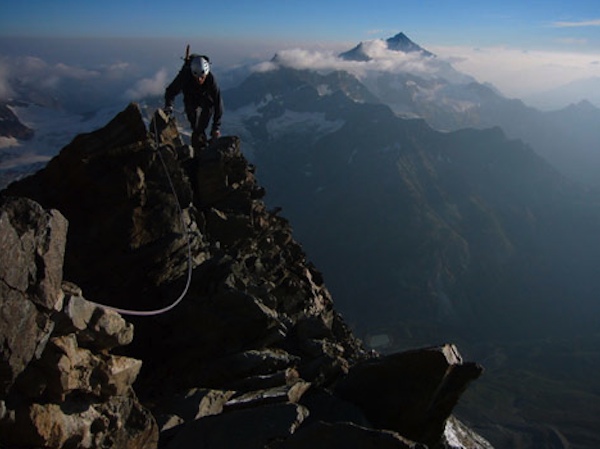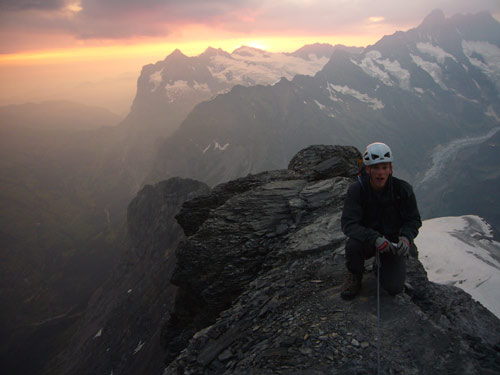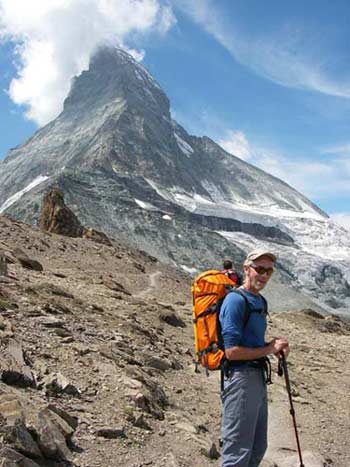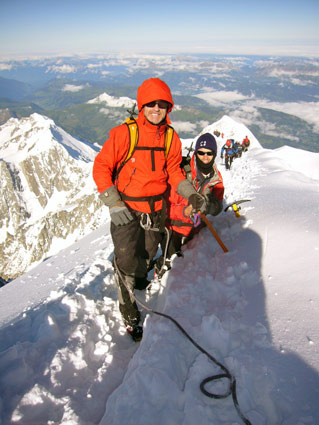Mt. Blanc, the Matterhorn, and the Eiger Overview
Since the birth of mountaineering, these three peaks have fascinated the climbing public like no others: Mont Blanc because its ascent heralded the dawn of alpine climbing, and because its 15,771-foot summit is the highest point in Western Europe; the Matterhorn because of its appearance as an unclimbable rock tower; and the Eiger, with its dark, brooding North Face, the last of the "Three Great Problems" to be conquered.
On route to the summit of Mont Blanc on a cold but clear day.
Though now climbed regularly, these peaks still offer a unique and unmistakable alpine challenge, and the character of the climbing encountered on them is as diverse as the peaks themselves.
On Mont Blanc the primary challenge is high altitude glacier climbing, where weather, snow and ice conditions, acclimatization, and personal fitness all combine to provide the key to a successful summit climb.
In contrast, the ascents of the Eiger and Matterhorn call upon technical rock skills and the ability to move quickly and efficiently along the spiny crests of their exposed alpine ridges. Because the three peaks are located in very different parts of the Alps, each gives the climber an unusual opportunity to explore the cultural and environmental diversity of this magnificent mountain range.
Mt. Blanc, the Matterhorn, and the Eiger The Alps Trilogy Peaks Chamonix - Mont Blanc
The beautiful summit of Mont Blanc (15,771') is considered one of the world's great climbing prizes, and our routes to the top include varied snow and ice climbing on immense glaciers as well as a dramatic finish on a ridge crest that leads us to Western Europe's highest summit. The route we choose will depend on conditions, but we most typically climb the Gouter Route or a traverse via Mont Blanc du Tacul and Mont Maudit. After a night spent in a high alpine refuge, we rise very early to take advantage of the frozen snow of the early morning hours. Our routes wind their way up the immense glaciers which cover the entire north and west sides of Mont Blanc, eventually leading to a dramatic ridge crest and Western Europe's highest summit. Surrounded by immense glaciers and offering views of some of the most beautiful alpine peaks in the world, this is an impressive and photogenic climb from beginning to end.
Zermatt - The Matterhorn
On the approach to the Matterhorn. John Elley
This looming rock tower truly dominates the valley town of Zermatt (5257 feet). Rising 9500 feet above the valley, the Matterhorn, like Mont Blanc, stands as one of the great symbols of mountaineering achievement. In 1865 this dark rock tower remained one of the final major unclimbed summits of the Alps. When at last Whymper's party was successful in reaching the airy summit on July 14 of that year, a tragic accident on the descent, in which four of the seven climbers were killed, only served to increase the mountain's reputation of impregnability. Made easier by the presence of fixed ropes and other anchors, today the climb does not appear so fearsome as it did over a century ago. However, it still remains a long and very exposed route and one which offers the climber significant challenges. After a night in the Hornli Hut we ascend the arete of the same name which rises nearly in a straight line to the 14,691-foot summit astride the Swiss and Italian border. The route is almost entirely on rock with only occasional snow patches where we leave the sharp ridge crest and climb gullies and chimneys on its flanks.
The Eiger
In the heart of the Bernese Oberland, classic wooden Swiss chalets dot the hillsides amid green fields of grass and flowers. No other part of Switzerland epitomizes the traditional alpine vista as well as the valleys of Grindelwald and Lauterbrunnen. Our route of ascent on the Eiger is the Mittellegi Ridge, a fine dividing line between the mile-high North Face and the Fiescher Glacier.
On route to the summit of the Eiger at dawn. Brandon Elley
Our approach to this seemingly remote ridge is via the incredible Jungfraujoch Railway which enters on the west side of the Eiger, tunnels through the peak, passes the infamous North Face "windows" (often used as routes of retreat for storm-battered Eigerwand climbers), and finally emerges high on the southeast face at the Eismeer station at 10,364 feet. We disembark, traverse the upper reaches of the Fiescher Glacier, and climb the final slopes to the Mittellegi Hut which stands on the ridge at just over 11,000 feet. From here the route climbs steadily along the exposed ridge to the Eiger's summit, mixing third, fourth, and fifth class rock climbing and offering significant exposure.
Mt. Blanc, the Matterhorn, and the Eiger Details For experienced alpinists, AAI offers a ten-day program to climb these three classics, beginning in Chamonix, France and ending in Grindelwald, Switzerland. This program runs as does the 7-day program described above, then includes a day of travel to Grindelwald, and two days for the ascent of the spectacular Mittellegi Ridge on the Eiger. With only two days dedicated to the beautiful journey between alpine villages, you will enjoy ten days of spectacular climbing in three distinct areas of the region that fostered the birth of alpine mountaineering.
Prerequisites For any of these challenging climbs, you need to be in excellent physical condition and be able to climb 4000 feet in 4 hours including rest stops while carrying a 25 pound pack. You should also have experience with glacier travel and the use of crampons and ice axe in all fundamental techniques. For the Matterhorn and the Eiger, you need to have multi-pitch Class 5 rock climbing experience, be comfortable following at least 5.7, and have made 5th class ascents in mountaineering boots.
Program costs include guide fees and group climbing equipment. Not included are meals, lodging, telepheriques, and transportation between cities.
Flight Information Most people fly into Geneva the day before the program begins. Airport transfers are available from Geneva to Chamonix, Zermatt, or Grindelwald; please contact AAI's Travel Coordinator if you need assistance in arranging a transfer. Departure flights should be scheduled for the day after the last course day.
Program Cost Inclusions and Exclusions Inclusions : Guide fee; group gear (ropes and hardware).
Exclusions : Food, lodging, and local transportation for the client. The cost does include those expenses for the guide. Estimates on costs can be provided when you discuss your program with the Institute's program coordinator.
When to Climb? Most climbers ask us when the best times to climb the Mont Blanc, Matterhorn, and Eiger are. The answer varies year by year, depending on conditions and weather. Our lead Alps guide offers this assessment:
"The best climbing conditions for the Matterhorn and the Eiger are from late August to early September (both of those are mostly rock climbs, so the drier the better). Mont Blanc (mostly snow and ice) is best in the early season (July to early August) when there is the most snow. However, it is much more forgiving in conditions, and in some years it is great even through the end of September.
Of course, there is no way of knowing what conditions will be like very far in advance we'll have a good idea of what the season will be like in June and early July, but before that it's just a guess. In light of that, here are some other considerations to make when figuring out your preferred dates:
It's most crowded from Aug 1 to Aug 21 in the Alps. It's much less crowds in early September, but there's a chance of snowfall that can ice-up the Matterhorn or the Eiger.
In most years the best climbing for the Matterhorn and the Eiger is in late August. However, in July there will likely be more good snow and ice options. If it is a hot summer, then mid-July and beyond is fine for the Matterhorn and Eiger as well as for Mont Blanc. If you really value quiet times with fewer climbers, late August and early September are best.
In choosing your dates, consider your priorities (crowds, snow and ice, classic rock, doing it all, etc.), consider what is most convenient for your personal schedule, and remember that you are heading for the mountains - a realm that is never totally predictable. Fortunately in the Alps, if one goal is temporarily out of shape, there are always great alternatives, and you can count on having a great climbing trip whatever the conditions end up being."
Mt. Blanc, the Matterhorn, and the Eiger Program Details and Dates 5 or 7-Day Chamonix - Mont Blanc Program
After an orientation in Chamonix, France, the program begins with a one-day ascent of the Cosmiques Arete on the Aiguille du Midi (12,602'). This classic mixed route gives us a chance to become acquainted with the Mont Blanc Massif and to begin the process of acclimatization in preparation for our ascent of Mont Blanc. In addition to the Aiguille du Midi, we review glacier skills or make a second ascent before tackling Mont Blanc (possibilities are the East Arete of the Pyramide du Tacul or the Midi-Plan Traverse).
Length: 5 days
Group Size: 1 or 2 climbers with one guide
Cost: 2:1 $2700; 1:1 $4100
We highly recommend the seven-day program because it allows us to climb of one of the classic routes on the beautiful Tour Ronde, the Southeast Ridge or the North Face.
Length: 7 days
Group Size: 1 or 2 climbers with one guide
Cost: 2:1 $3780; 1:1 $5740
Or if you wish to climb other Guided Ascents in the French Alps , additional days can be added.
Length: 1 day and up
Group Size: 1 to 4 climbers with one guide
Cost (per person, per day): 4:1 $350; 3:1 $430; 2:1 $540; 1:1 $820
5-Day Zermatt - Matterhorn Program
The iconic and imposing Matterhorn has captured the alpine aspirations of climbers for generations. Michael Powers
We meet in the alpine village of Zermatt, Switzerland, and begin our series of ascents with a two-day climb of the photogenic Rothorn. We approach a high hut by hiking through a beautiful alpine valley and gorge; on summit day we enjoy moderate glacial terrain, the climb of a moderately steep snow face to reach a ridge, and spectacular mid-fifth class rock climbing on a sharp arete that takes us right to the summit. Our second ascent is on the famous Breithorn which rises between Monte Rosa and the Matterhorn. We make an airy traverse of this peak on snow, ice, and rock, climbing and rappelling a series of horns as we make our way to the summit. We then have an easy day as we make our way to the Hornli Hut and prepare for summit day on the Matterhorn.
Maximum Climber to Guide Ratio: 2:1 on the first two climbs and 1:1 on the Matterhorn
Cost: 2:1 $3990; 1:1 $4600
If you wish to climb other classic ascents in the Swiss Alps, additional days can be added.
Length: 1 day and up
Group Size: 1 to 4 climbers with one guide
Cost (per person, per day): 2:1 $720; 1:1 $920
8-Day Mont Blanc and Matterhorn Program
If you wish to experience two of the finest alpine routes in France and Switzerland, consider Mont Blanc and the Matterhorn in a single, eight-day program. We begin with five days of climbing in the Chamonix area, then travel by train to Zermatt. This program offers a great deal of flexibility (as well as a skills review and thorough acclimatization), a great overview of the finest terrain in the Alps, and a chance at two of the world's most sought-after summits.
Maximum Climber to Guide Ratio: 2:1 except on the Matterhorn which is 1:1
Cost: 2:1 $5460; 1:1 $6580
11-Day Mont Blanc, Matterhorn, & Eiger Program
For experienced alpinists, AAI offers an eleven-day program to climb these three classics, beginning in Chamonix, France and ending in Grindelwald, Switzerland. This program runs as does the 8-day program described above, then includes a day of travel to Grindelwald, and two days for the ascent of the spectacular Mittellegi Ridge on the Eiger. With only two days dedicated to the beautiful journey between alpine villages, you will enjoy eleven days of spectacular climbing in three distinct areas of the region that fostered the birth of alpine mountaineering.
Maximum Climber to Guide Ratio: 2:1 except on the Matterhorn and Eiger which are 1:1
Cost: 2:1 $8220; 1:1 $9340
Dates Please call the AAI office at 360-671-1505 (Toll Free: 1-800-424-2249) or emai:[email protected] to set up dates for this program.
Mt. Blanc, the Matterhorn, and the Eiger Related Courses
Program Finder
By Location
United States - Alaska
United States - Washington
United States - California
United States - Nevada
United States - Colorado
United States - Utah
Canada - British Columbia
South America - Argentina
South America - Bolivia
South America - Ecuador
South America - Patagonia
South America - Peru
Europe - Alps and Caucasus
Asia - Nepal and Tibet
Asia - Laos, Thailand, & Vietnam
Asia - China
Asia - Japan
Africa - Tanzania
Pacific and Antarctica
By Program Type
Instructional Courses
Group Summit Climbs
Expeditions
Skills Expeditions
Private Guided Programs
Treks, Tours, & Backpacking
Corporate Outings & Services
Government & Military
By Activity
Rock Climbing
Ice Climbing
Alpine Climbing
High-Altitude Climbing
Trekking and Backpacking
Skiing & Snowboarding
Guide Training & Rescue
Avalanche Training
Departure Month
Difficulty Level
Beginner
Moderate
Intermediate
Advanced
Very Advanced
x





